(word完整版)初中英语现在完成时详解
- 格式:doc
- 大小:47.01 KB
- 文档页数:5
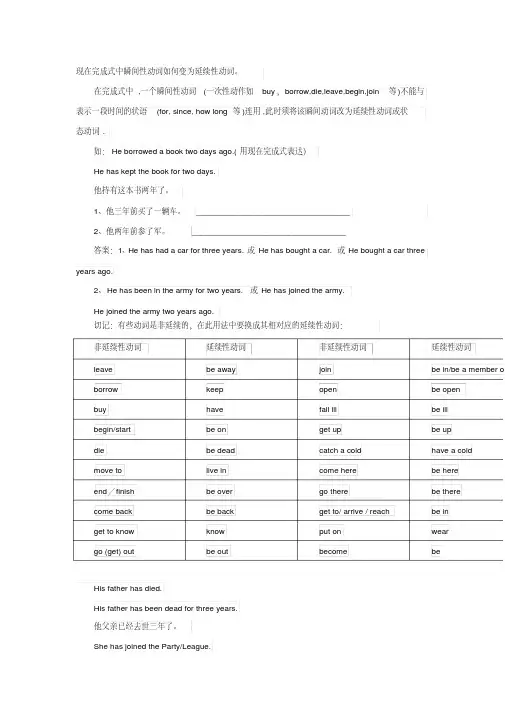
现在完成式中瞬间性动词如何变为延续性动词。
在完成式中,一个瞬间性动词(一次性动作如buy,borrow,die,leave,begin,join等)不能与表示一段时间的状语(for, since, how long等)连用,此时须将该瞬间动词改为延续性动词或状态动词.如:He borrowed a book two days ago.(用现在完成式表达)He has kept the book for two days.他持有这本书两年了。
1、他三年前买了一辆车。
___________________________________2、他两年前参了军。
___________________________________答案:1、He has had a car for three years.或He has bought a car. 或He bought a car threeyears ago.2、He has been in the army for two years.或He has joined the army.He joined the army two years ago.切记:有些动词是非延续的,在此用法中要换成其相对应的延续性动词:非延续性动词延续性动词非延续性动词延续性动词leave be away join be in/be a member o borrow keep open be openbuy have fall ill be illbegin/start be on get up be updie be dead catch a cold have a coldmove to live in come here be hereend/finish be over go there be therecome back be back get to/ arrive / reach be inget to know know put on weargo (get) out be out become beHis father has died.His father has been dead for three years.他父亲已经去世三年了。
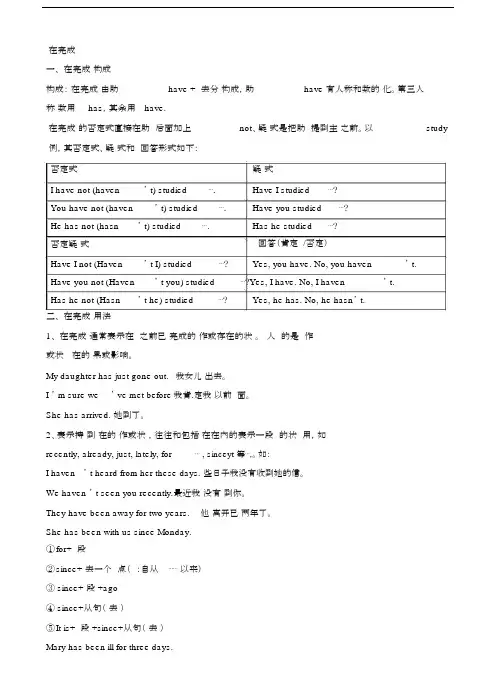
在完成一、在完成构成构成:在完成由助have + 去分构成,助have 有人称和数的化。
第三人称数用has,其余用have.在完成的否定式直接在助后面加上not、疑式是把助提到主之前。
以study 例,其否定式、疑式和回答形式如下:否定式疑式I have not (haven ’ t) studied ⋯. Have I studied ⋯?You have not (haven ’ t) studied ⋯. Have you studied ⋯?He has not (hasn ’ t) studied ⋯. Has he studied ⋯?否定疑式回答(肯定 /否定)Have I not (Haven ’ t I) studied ⋯? Yes, you have. No, you haven ’ t.Have you not (Haven ’ t you) studied ⋯?Yes, I have. No, I haven ’ t.Has he not (Hasn ’ t he) studied ⋯? Yes, he has. No, he hasn’ t.二、在完成用法1、在完成通常表示在之前已完成的作或存在的状。
人的是作或状在的果或影响。
My daughter has just gone out.我女儿出去。
I ’ m sure we’ ve met before我肯.定我以前面。
She has arrived. 她到了。
2、表示持到在的作或状,往往和包括在在内的表示一段的状用,如recently, already, just, lately, for⋯, sinceyt等⋯,。
如:I haven’ t heard from her these days.些日子我没有收到她的信。
We haven ’ t seen you recently.最近我没有到你。
They have been away for two years.他离开已两年了。
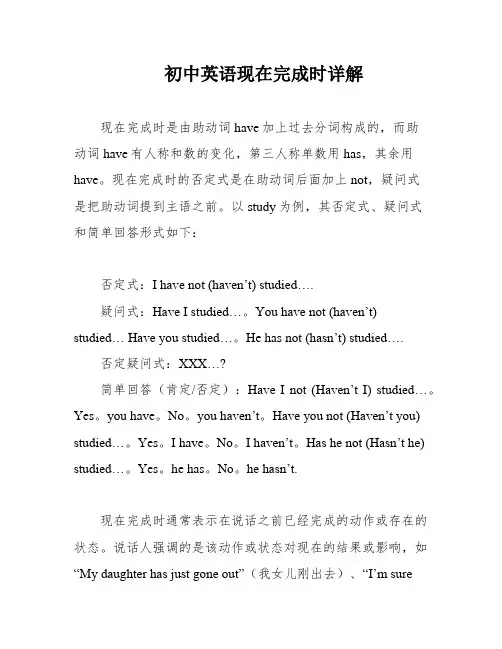
初中英语现在完成时详解现在完成时是由助动词have加上过去分词构成的,而助动词have有人称和数的变化,第三人称单数用has,其余用have。
现在完成时的否定式是在助动词后面加上not,疑问式是把助动词提到主语之前。
以study为例,其否定式、疑问式和简单回答形式如下:否定式:I have not (haven’t) studied….疑问式:Have I studied…。
You have not (haven’t) studied… Have you studied…。
He has not (hasn’t) studied….否定疑问式:XXX…?简单回答(肯定/否定):Have I not (Haven’t I) studied…。
Yes。
you have。
No。
you haven’t。
Have you not (Haven’t you) studied…。
Yes。
I have。
No。
I haven’t。
Has he not (Hasn’t he) studied…。
Yes。
he has。
No。
he hasn’t.现在完成时通常表示在说话之前已经完成的动作或存在的状态。
说话人强调的是该动作或状态对现在的结果或影响,如“My daughter has just gone out”(我女儿刚出去)、“I’m surewe’ve met before”(我肯定我们以前见过面)和“She has arrived”(她到了)等。
此外,现在完成时还可以表示持续到现在的动作或状态,往往和包括现在在内的表示一段时间的状语连用,如recently、already、just、lately、for…、since…、yet等。
例如,“I haven’t heard from her these days”(这些日子我没有收到她的信)和“XXX”(最近我们没有见到你)等。
还有一些表示时间的短语也可以和现在完成时连用,如:①for+时段②since+过去一个时间点(译为:自从……以来)③since+时段+ago④since+从句(过去时)Mary has been ill for three days。
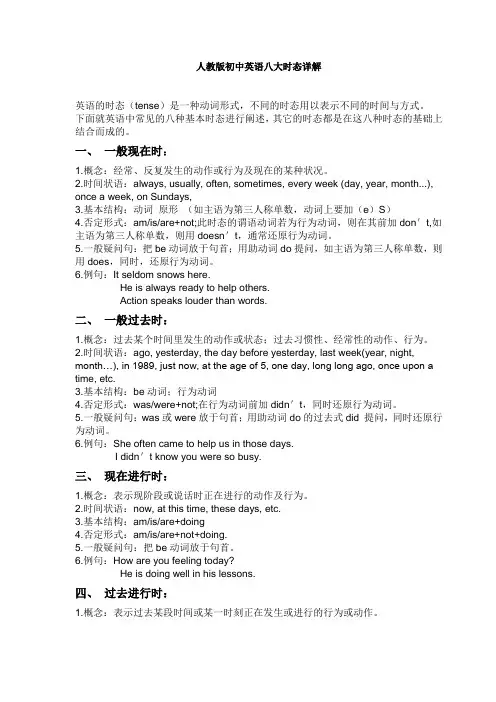
人教版初中英语八大时态详解英语的时态(tense)是一种动词形式,不同的时态用以表示不同的时间与方式。
下面就英语中常见的八种基本时态进行阐述,其它的时态都是在这八种时态的基础上结合而成的。
一、一般现在时:1.概念:经常、反复发生的动作或行为及现在的某种状况。
2.时间状语:always, usually, often, sometimes, every week (day, year, month...), once a week, on Sundays,3.基本结构:动词原形(如主语为第三人称单数,动词上要加(e)S)4.否定形式:am/is/are+not;此时态的谓语动词若为行为动词,则在其前加don't,如主语为第三人称单数,则用doesn't,通常还原行为动词。
5.一般疑问句:把be动词放于句首;用助动词do提问,如主语为第三人称单数,则用does,同时,还原行为动词。
6.例句:It seldom snows here.He is always ready to help others.Action speaks louder than words.二、一般过去时:1.概念:过去某个时间里发生的动作或状态;过去习惯性、经常性的动作、行为。
2.时间状语:ago, yesterday, the day before yesterday, last week(year, night, month…), in 1989, just now, at the age of 5, one day, long long ago, once upon a time, etc.3.基本结构:be动词;行为动词4.否定形式:was/were+not;在行为动词前加didn't,同时还原行为动词。
5.一般疑问句:was或were放于句首;用助动词do的过去式did 提问,同时还原行为动词。
6.例句:She often came to help us in those days.I didn't know you were so busy.三、现在进行时:1.概念:表示现阶段或说话时正在进行的动作及行为。
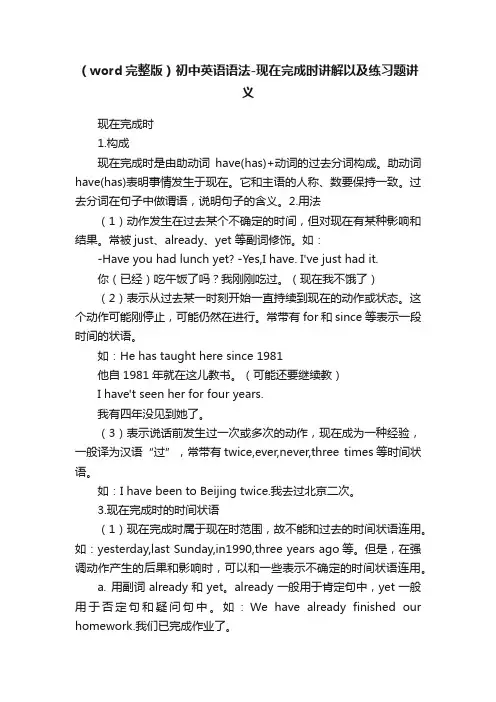
(word完整版)初中英语语法-现在完成时讲解以及练习题讲义现在完成时1.构成现在完成时是由助动词have(has)+动词的过去分词构成。
助动词have(has)表明事情发生于现在。
它和主语的人称、数要保持一致。
过去分词在句子中做谓语,说明句子的含义。
2.用法(1)动作发生在过去某个不确定的时间,但对现在有某种影响和结果。
常被just、already、yet 等副词修饰。
如:-Have you had lunch yet? -Yes,I have. I've just had it.你(已经)吃午饭了吗?我刚刚吃过。
(现在我不饿了)(2)表示从过去某一时刻开始一直持续到现在的动作或状态。
这个动作可能刚停止,可能仍然在进行。
常带有for和since等表示一段时间的状语。
如:He has taught here since 1981他自1981年就在这儿教书。
(可能还要继续教)I have't seen her for four years.我有四年没见到她了。
(3)表示说话前发生过一次或多次的动作,现在成为一种经验,一般译为汉语“过”,常带有twice,ever,never,three times等时间状语。
如:I have been to Beijing twice.我去过北京二次。
3.现在完成时的时间状语(1)现在完成时属于现在时范围,故不能和过去的时间状语连用。
如:yesterday,last Sunday,in1990,three years ago等。
但是,在强调动作产生的后果和影响时,可以和一些表示不确定的时间状语连用。
a. 用副词already和yet。
already一般用于肯定句中,yet一般用于否定句和疑问句中。
如:We have already finished our homework.我们已完成作业了。
They haven't finished their homework yet.他们还没有完成作业。
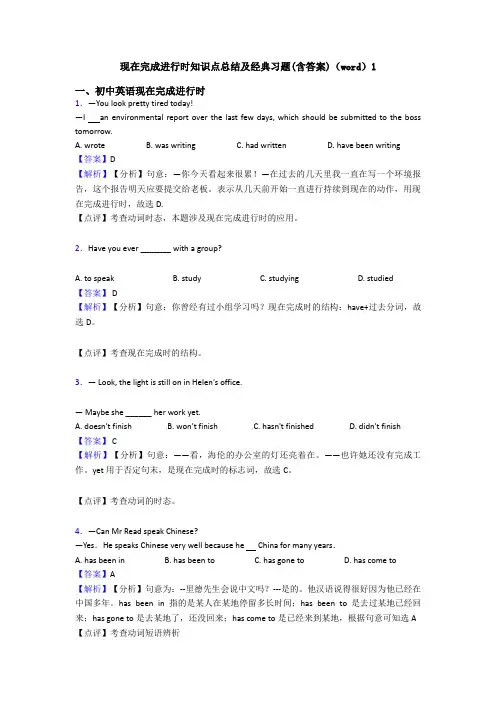
现在完成进行时知识点总结及经典习题(含答案)(word)1一、初中英语现在完成进行时1.—You look pretty tired today!—I an environmental report over the last few days, which should be submitted to the boss tomorrow.A. wroteB. was writingC. had writtenD. have been writing【答案】D【解析】【分析】句意:—你今天看起来很累!—在过去的几天里我一直在写一个环境报告,这个报告明天应要提交给老板。
表示从几天前开始一直进行持续到现在的动作,用现在完成进行时,故选D.【点评】考查动词时态,本题涉及现在完成进行时的应用。
2.Have you ever _______ with a group?A. to speakB. studyC. studyingD. studied【答案】 D【解析】【分析】句意:你曾经有过小组学习吗?现在完成时的结构:have+过去分词,故选D。
【点评】考查现在完成时的结构。
3.— Look, the light is still on in Helen's office.— Maybe she ______ her work yet.A. doesn't finishB. won't finishC. hasn't finishedD. didn't finish【答案】 C【解析】【分析】句意:——看,海伦的办公室的灯还亮着在。
——也许她还没有完成工作。
yet用于否定句末,是现在完成时的标志词,故选C。
【点评】考查动词的时态。
4.—Can Mr Read speak Chinese?—Yes.He speaks Chinese very well because he China for many years.A. has been inB. has been toC. has gone toD. has come to【答案】A【解析】【分析】句意为:--里德先生会说中文吗?---是的。
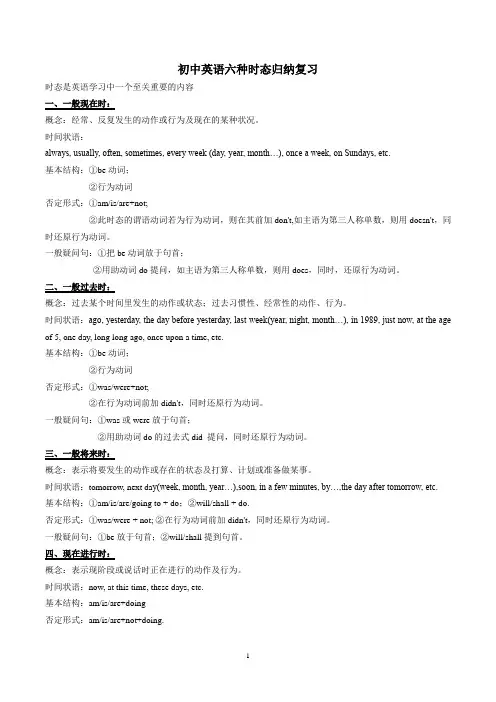
初中英语六种时态归纳复习时态是英语学习中一个至关重要的内容一、一般现在时:概念:经常、反复发生的动作或行为及现在的某种状况。
时间状语:always, usually, often, sometimes, every week (day, year, month…), once a week, on Sundays, etc.基本结构:①be动词;②行为动词否定形式:①am/is/are+not;②此时态的谓语动词若为行为动词,则在其前加don't,如主语为第三人称单数,则用doesn't,同时还原行为动词。
一般疑问句:①把be动词放于句首;②用助动词do提问,如主语为第三人称单数,则用does,同时,还原行为动词。
二、一般过去时:概念:过去某个时间里发生的动作或状态;过去习惯性、经常性的动作、行为。
时间状语:ago, yesterday, the day before yesterday, last week(year, night, month…), in 1989, just now, at the age of 5, one day, long long ago, once upon a time, etc.基本结构:①be动词;②行为动词否定形式:①was/were+not;②在行为动词前加didn't,同时还原行为动词。
一般疑问句:①was或were放于句首;②用助动词do的过去式did 提问,同时还原行为动词。
三、一般将来时:概念:表示将要发生的动作或存在的状态及打算、计划或准备做某事。
时间状语:tomorrow, next da y(week, month, year…),soon, in a few minutes, by…,the day after tomorrow, etc.基本结构:①am/is/are/going to + do;②will/shall + do.否定形式:①was/were + not; ②在行为动词前加didn't,同时还原行为动词。
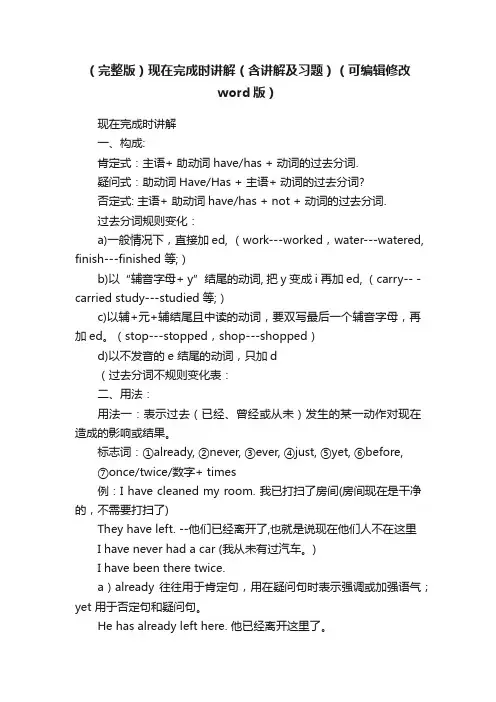
(完整版)现在完成时讲解(含讲解及习题)(可编辑修改word版)现在完成时讲解一、构成:肯定式:主语+ 助动词have/has + 动词的过去分词.疑问式:助动词Have/Has + 主语+ 动词的过去分词?否定式: 主语+ 助动词have/has + not + 动词的过去分词.过去分词规则变化:a)一般情况下,直接加ed, (work---worked,water---watered, finish---finished 等;)b)以“辅音字母+ y”结尾的动词, 把y 变成i 再加ed, (carry-- -carried study---studied 等;)c)以辅+元+辅结尾且中读的动词,要双写最后一个辅音字母,再加ed。
(stop---stopped,shop---shopped)d)以不发音的e 结尾的动词,只加d(过去分词不规则变化表:二、用法:用法一:表示过去(已经、曾经或从未)发生的某一动作对现在造成的影响或结果。
标志词:①already, ②never, ③ever, ④just, ⑤yet, ⑥before,⑦once/twice/数字+ times例:I have cleaned my room. 我已打扫了房间(房间现在是干净的,不需要打扫了)They have left. --他们已经离开了,也就是说现在他们人不在这里I have never had a car (我从未有过汽车。
)I have been there twice.a)already 往往用于肯定句,用在疑问句时表示强调或加强语气;yet 用于否定句和疑问句。
He has already left here. 他已经离开这里了。
Has he already left here? 他(真的)已经离开这里了吗?(表示加强语气)My teachers haven’t had breakfast yet. 我的老师们还没有吃早饭。
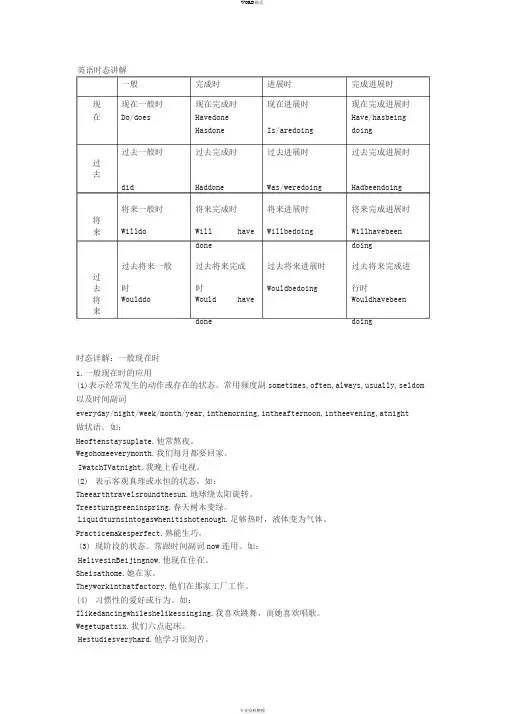
英语时态讲解一般完成时进展时完成进展时现现在一般时现在完成时现在进展时现在完成进展时在Do/does Havedone Have/hasbeingHasdone Is/aredoing doing过去一般时过去完成时过去进展时过去完成进展时过去did Haddone Was/weredoing Hadbeendoing将来一般时将来完成时将来进展时将来完成进展时将Willdo Will have Willbedoing Willhavebeen 来done doing过去将来一般过去将来完成过去将来进展时过去将来完成进过Wouldbedoing去时时行时将Woulddo Would have Wouldhavebeen 来done doing时态详解:一般现在时1.一般现在时的应用(1)表示经常发生的动作或存在的状态。
常用频度副sometimes,often,always,usually,seldom 以及时间副词everyday/night/week/month/year,inthemorning,intheafternoon,intheevening,atnight做状语。
如:Heoftenstaysuplate.他常熬夜。
Wegohomeeverymonth.我们每月都要回家。
IwatchTVatnight.我晚上看电视。
(2)表示客观真理或永恒的状态。
如:Theearthtravelsroundthesun.地球绕太阳旋转。
Treesturngreeninspring.春天树木变绿。
Liquidturnsintogaswhenitishotenough.足够热时,液体变为气体。
Practicemakesperfect.熟能生巧。
(3)现阶段的状态。
常跟时间副词now连用。
如:HelivesinBeijingnow.他现在住在。
Sheisathome.她在家。
Theyworkinthatfactory.他们在那家工厂工作。
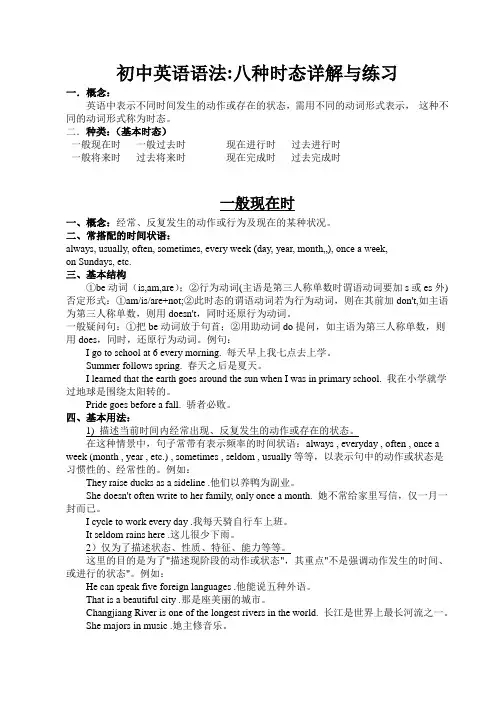
初中英语语法:八种时态详解与练习一.概念:英语中表示不同时间发生的动作或存在的状态,需用不同的动词形式表示,这种不同的动词形式称为时态。
二.种类:(基本时态)一般现在时一般过去时现在进行时过去进行时一般将来时过去将来时现在完成时过去完成时一般现在时一、概念:经常、反复发生的动作或行为及现在的某种状况。
二、常搭配的时间状语:always, usually, often, sometimes, every week (day, year, month…), once a week,on Sundays, etc.三、基本结构①be动词(is,am,are);②行为动词(主语是第三人称单数时谓语动词要加s或es外) 否定形式:①am/is/are+not;②此时态的谓语动词若为行为动词,则在其前加don't,如主语为第三人称单数,则用doesn't,同时还原行为动词。
一般疑问句:①把be动词放于句首;②用助动词do提问,如主语为第三人称单数,则用does,同时,还原行为动词。
例句:I go to school at 6 every morning. 每天早上我七点去上学。
Summer follows spring. 春天之后是夏天。
I learned that the earth goes around the sun when I was in primary school. 我在小学就学过地球是围绕太阳转的。
Pride goes before a fall. 骄者必败。
四、基本用法:1) 描述当前时间内经常出现、反复发生的动作或存在的状态。
在这种情景中,句子常带有表示频率的时间状语:always , everyday , often , once a week (month , year , etc.) , sometimes , seldom , usually等等,以表示句中的动作或状态是习惯性的、经常性的。
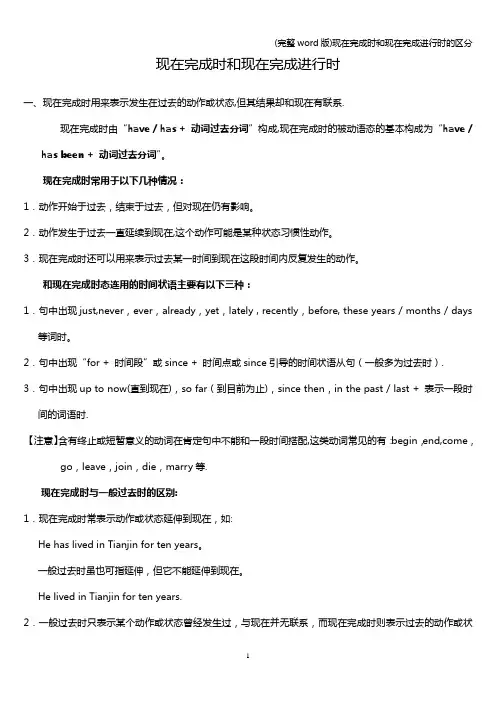
现在完成时和现在完成进行时一、现在完成时用来表示发生在过去的动作或状态,但其结果却和现在有联系.现在完成时由“have / has + 动词过去分词”构成,现在完成时的被动语态的基本构成为“have / has been + 动词过去分词”。
现在完成时常用于以下几种情况:1.动作开始于过去,结束于过去,但对现在仍有影响。
2.动作发生于过去一直延续到现在,这个动作可能是某种状态习惯性动作。
3.现在完成时还可以用来表示过去某一时间到现在这段时间内反复发生的动作。
和现在完成时态连用的时间状语主要有以下三种:1.句中出现just,never,ever,already,yet,lately , recently,before, these years / months / days 等词时。
2.句中出现“for + 时间段”或since + 时间点或since引导的时间状语从句(一般多为过去时). 3.句中出现up to now(直到现在),so far(到目前为止),since then,in the past / last + 表示一段时间的词语时.【注意】含有终止或短暂意义的动词在肯定句中不能和一段时间搭配,这类动词常见的有:begin,end,come,go,leave,join,die,marry等.现在完成时与一般过去时的区别:1.现在完成时常表示动作或状态延伸到现在,如:He has lived in Tianjin for ten years。
一般过去时虽也可指延伸,但它不能延伸到现在。
He lived in Tianjin for ten years.2.一般过去时只表示某个动作或状态曾经发生过,与现在并无联系,而现在完成时则表示过去的动作或状态对现在有影响。
We'd better stop her from doing such hard work,for she has been seriously ill.(过去的动作对现在造成了影响)He was ill last week.(并没有涉及现在的情况)3.现在完成时的时间状语可以同不确定的过去时间状语连用(如already,just,before,recently等),还可以同包括现在时间在内的时间状语连用(如today,this morning,this month,this year等),还可以和时间段连用。
初中英语语法⼋⼤时态总结(完整版)初中英语语法⼋⼤时态⼀.⼀般现在时1. 结构肯定句式:主语+动词原形/动词的第三⼈称单数+其他否定句式:主语+ (助动词)don't/doesn't +动词原形+其他⼀般疑问句式:Do/Does+主语+动词原形+其他简略回答:(肯)Yes,主语+do/does (否)No,主语+do/does not缩写形式: don't = do not does n't = does not例句:He often goes swimming in summer.I usually leave home for school at 7 every morning.1)表⽰经常的、习惯性的动作或存在的状态,常与表⽰频度的副词连⽤。
常⽤的频度副词有:always、often、usually、seldom、never、sometimes, every week (day, year, month …),once a week, on Su nday频度副词在句中通常放在⾏为动词之前,系动词、助动词之后。
例⼥⼝: He often goes swimming in summer.I usually leave home for school at 7 every morning.2)表⽰主语具备的性格、特征和能⼒等。
例如:All my family love football .My sister is always ready to help others .Ann writes good En glish but does not speak well.3)表⽰客观真理、客观存在、⾃然现象。
例如:The earth moves around the sun.Shan ghai lies in the east of China.4)表⽰按计划或安排好的,或将要发⽣的动作,可⽤⼀般现在时表将来。
现在完成时知识点详解(初中英语专项复习)知识点01现在完成时基本结构【语法详解】主语+have/has+动词的过去分词①肯定句:主语+have/has+动词的过去分词+宾语.①否定句:主语+have/has+not+动词的过去分词)+宾语.①一般疑问句:Have/Has+主语+动词的过去分词+宾语.①特殊疑问句:特殊疑问词或词组+一般疑问句(have/has+主语+过去分词(V-ed)+其他)【即学即练】—In the past few years,China’s space program__________a lot.—That’s true.It successfully sent twelve more astronauts to the space station.A.achieves B.achieved C.has achieved D.is achieving【答案】C【详解】句意:——在过去几年,中国的航天已经取得了很大的成就。
——对的,它成功地将12名宇航员送入了太空站。
考查时态。
achieves一般现在时;achieved一般过去时;has achieved现在完成时;is achieving 现在进行时。
根据“In the past few years”可知,用现在完成时,故选C。
知识点02过去分词变化规则【语法详解】1.规则动词:规则动词的过去分词的构成规则与规则动词的过去式的构成规则相同。
变化规则有四点:(1)一般动词,在词尾直接加"-ed"。
work→worked→worked visit→visited→visited(2)以"e"结尾的动词,只在词尾加"-d"。
live→lived→lived(3)以"辅音字母+y"结尾的动词,将"y"变为"i",再加"-ed"。
study→studied→studied cry→cried→cried(4)重读闭音节结尾,末尾只有一个辅音字母,先双写该辅音字母,再加"-ed"。
时态现在完成时一.根本结构:助动词have/has+过去分词(done)。
表示过去发生的动作对现在造成的影响,或过去发生的动作还未结束,一直持续到现在或将来,重点在于对现在的影响。
二.句型:否认句:主语+have/has+not+过去分词+其他.一般疑问句:Have/Has+主语+过去分词+其他.简略答语:Yes,主语+have/has.(肯定)No,主语+haven't/hasn't.(否认)三.用法1.“已完成〞用法:表示一个过去发生并结束的动作对现在造成的影响或结果。
这一类情况可以细致分为下述两种情况。
1〕表示开始于过去的动作刚刚结束。
常和just,now,already,yet,not yet等不确定的时间状语连用。
LiMinghasjustturnedoffthelight.李明刚刚把灯关上。
〔说明现在灯关上了〕I'vefinishedmyhomeworknow.现在我已经做完作业了。
〔说明可以交作业或做别的了〕2〕表示过去动作的结果,现在仍残留着。
一般不用时间状语。
Ihavelostmypen.我把笔丢了。
〔说明过去某时丢的,现在我还没找到这支笔〕Shehasbecomeateacher她.已经当了老师。
〔说明她现在仍是老师〕2.“未完成〞用法。
表示动作或状态从过去某时开始,持续到现在的动作〔用行为动词表示〕或状态〔be动词表示〕,常与for〔+段时间〕、since(+时间点或过去时的句子)连用。
for+时段〔foralongtime,foramonth〕since+过去一个时间点〔译为:自从以来,如since1991、sinceyesterday〕since+时段+ago〔since2daysago〕④since+从句〔过去时〕●⑤Itis+时段+since+从句〔过去时〕⑥其它常见:today,thisweek〔month〕,lately,recently,thesedays,inthepastfewdays,duringthelasttwoweeks,,sofar,uptonow,till〔until〕now等。
初中英语语法现在完成时详细讲解现在完成时是英语中一种表示过去发生的动作对现在产生的影响或结果的时态。
它由"have/has + 过去分词"构成。
现在完成时的用法如下:
1. 表示过去发生的动作对现在产生的影响或结果:
①I have finished my homework.(我已经完成了我的作业。
)这里表示过去完成的动作是完成作业,现在的结果是作业已经完成。
②They have lived in this city for five years.(他们在这个城市已经生活了五年。
)这里表示过去完成的动作是生活在这个城市,现在的结果是他们已经在这个城市生活了五年。
2. 表示从过去某一时间点开始到现在一直持续的动作:
①She has worked at this company since 2010.(她从2010年起在这家公司工作。
)这里表示过去从2010年开始工作,到现在一直在这家公司工作。
3. 表示过去已经发生但时间未具体提及的动作:
①Have you ever been to Paris?(你去过巴黎吗?)这里表示过去是否有去过巴黎,但并未提及具体时间。
需要注意的是,现在完成时强调的是过去的动作与现在的关系,因此常用于包含现在的句子中。
同时,现在完成时通常与表示一段时间的时间状语连用,如for、since等,以强调动作的持续性或延续性。
另外,现在完成时不能与明确的过去时间状语连用,如yesterday、last week等,因为这些表示过去具体时间点的状语与现在完成时的
概念不符。
在这种情况下,应使用过去时态表示过去发生的动作。
现在完成时一、现在完成时构成构成:现在完成时由助动词have + 过去分词构成,助动词have 有人称和数的变化。
第三人称单数用has,其余用have.现在完成时的否定式直接在助动词后面加上not、疑问式是把助动词提到主语之前。
以study 为例,其否定式、疑问式和简单回答形式如下:1、现在完成时通常表示在说话之前已经完成的动作或存在的状态。
说话人强调的是该动作或状态对现在的结果或影响。
My daughter has just gone out. 我女儿刚出去。
I’m sure we’ve met before. 我肯定我们以前见过面。
She has arrived. 她到了。
2、表示持续到现在的动作或状态,往往和包括现在在内的表示一段时间的状语连用,如recently, already, just, lately, for…, since…,yet等。
如:I haven’t heard from her these days. 这些日子我没有收到她的信。
We haven’t seen you recently. 最近我们没有见到你。
They have been away for two years. 他们离开已经两年了。
She has been with us since Monday.①for+时段②since+过去一个时间点(译为:自从……以来)③since+时段+ago④since+从句(过去时)⑤It is+时段+since+从句(过去时)Mary has been ill for three days.I have lived here since 1998.注意:since和for的区别since后接时间点,如1993,last term, yesterday, the time I got therefor后接一段时间,表示“长达多久”,如ten years, a while, two days等。
3、表示短暂意义的动词如arrive, leave, borrow, buy, begin, start, die等,在完成时当中不能和表示一段时间的状语连用,因为它们表示的动作不可能持续。
因此,不能说:He has come here for 2 weeks. ×The old man has died for 4 months. ×They have left only for 5 minutes. ×4、has gone (to),has been (to), has been (in) 的区别Have/Has gone(to) :去了(现在不在说话现场,可能在路上和已经到)Where is your father?He has gone to Shanghai.Have/Has been (to) :去过(已不在去过的地方)My father has been to Shanghai.Have/has been in:呆了多久(还在所呆的地方)My father has been in Shanghai for two months. /since two months ago.5、现在完成时不能和表示过去的时间状语连用,如yesterday, last year, in 1976, two days ago, just now, when I came in,但可以和already, yet, sometimes, always, often, before, lately, recently, once, twice, ever, never等连用。
不能与when连用。
现在完成时往往同表示不确定的过去时间状语连用例如:She has already come. 她已经来了。
I haven’t read it yet. 我还没读过这个。
I have met him before. 我从前曾见过他。
Ma Hong has always been a good student. 马红一直是个好学生。
I have often seen him in the street. 我经常在街上看见他。
They have never been to Yan’an. 他们从未去过延安。
I haven't seen him lately. 我近来没看到他。
三、现在完成时的标志1、现在完成时的含义之一是过去完成的动作对现在仍有影响,用以下四大标志词可以表达这种含义:* 以already, just和yet为标志He has already got her help.他已得到她的帮助。
He has just seen the film.他刚刚看过这场电影。
He hasn't come back yet.他还没有回来。
* 以ever和never为标志This is the best film I have ever seen.这是我曾经看过的最好的一部电影。
He has never been to Beijing.他从没有到过北京。
* 以动作发生的次数为标志He says he has been to the USA three times. 他说他已经去过美国三次了。
* 以so far(到目前为止)为标+beforeHe has got to Beijing so far.到目前为止他已到了北京。
She has passed the exam so far.到目前为止她已经通过了考试。
2.过去已经开始的动作一直延续到现在, 甚至有可能继续延续下去,我们可以从动作“延续”的特性和“时间”点段的区分入手,进一步学习现在完成时。
①for+时段②since+过去一个时间点(过去从句)为标志四、瞬间动词buy, die, join, come,go ,leave, join ……不能直接与for since 连用。
要改变动词buy----have borrow -----keepcome/arrive/reach/get to-----be ingo out----be out leave ----be awaybegin-----be on finish----be overopen----be open close -----be closeddie----be dead1、have代替buyMy brother has had(不能用has bought) this bike for almost four years.2、用keep或have代替borrowI have kept(不能用have borrowed) the book for quite a few days.3、用be替代becomeHow long has your sister been a teacher?4、用have a cold代替catch a coldTom has had a cold since the day before yesterday.5、用wear代替put on6、用“be+形容词”代终止性动词be+married代marry be+ill代fall (get) illbe+dead代die be+asleep代fall (get) asleepbe+awake代wake/wake up be+gone代lose,die,sell,leavebe+open代open be closed代close/shutbe+missing(gone,lost)代lose7、用“be+副词”代终止性动词be+on代start begin “be+up”代get up“be+back(to)”代return to, come back to, go back to“be here (there)”代come(arrive, reach, get) here或go (arrive, reach, get) there 8、用“be+介词短语”代终止性动词1.“be in/at +地点”代替go to /come to2.用be in the army 代替join the army3.“be in/at +地点”代替move to常用瞬间动词变延续性动词表:1. have arrived at/in sw. got to/reached sw. come/gone/moved to sw.→have been in sw./at…相应的介词2. have come/gone back/retu rned → have been back3. have come/gone out →have been out4. have become → have been5. have closed / opened→ have been close/open6. have got up → have been up;7. have died → have been dead;8. have left sw. → have been away from sw.9. have fallen asle ep/got to sleep → have been asleep;10. have finished/ended/completed → have been over;11. have married → have been married;12. have started/begun to do sth. → have done sth.;13. have begun → have been on14. have borrowed/bought →have kept/had15. hav e lost → haven’t had16. have put on →have worn17. have caught /get a cold → have had a cold;18. have got to know → have known19. have/has gone to → have been in20. have joined/have taken part in the league/the Party/the army→have been a member of/ hav e been in/have been the Party’s member/the league member/the soldier…。